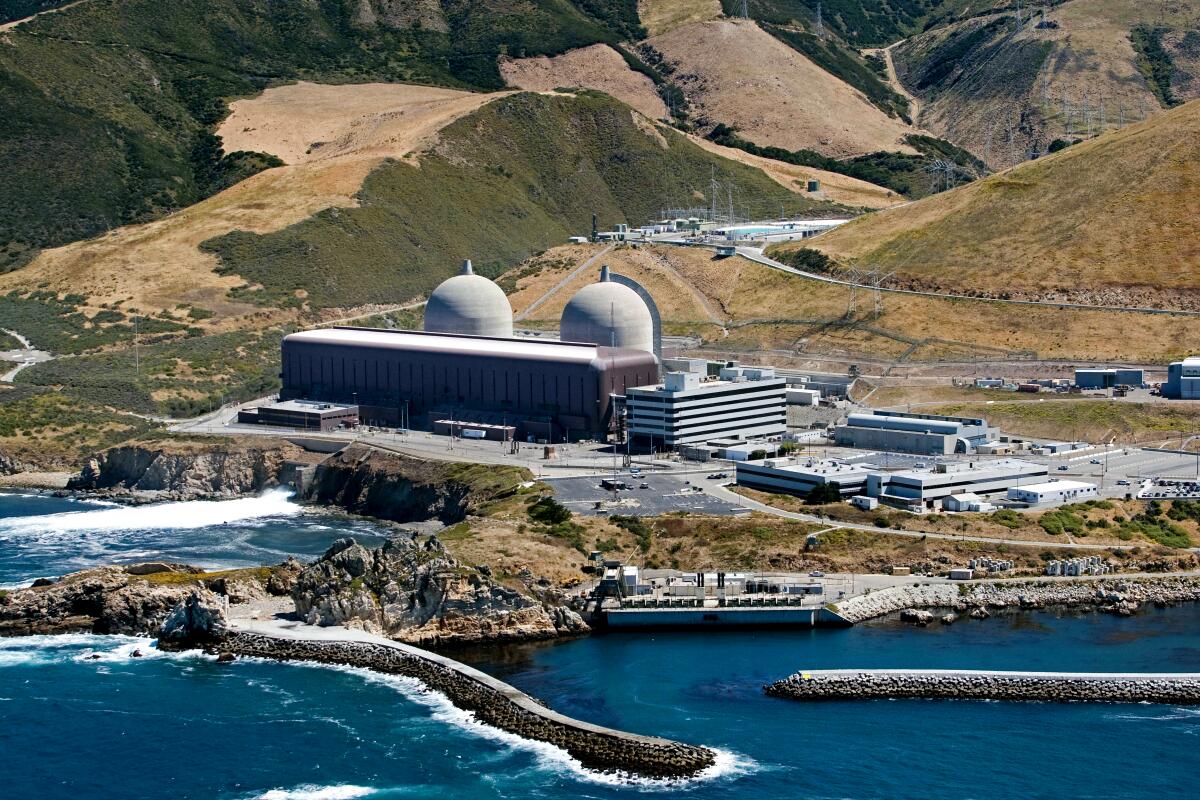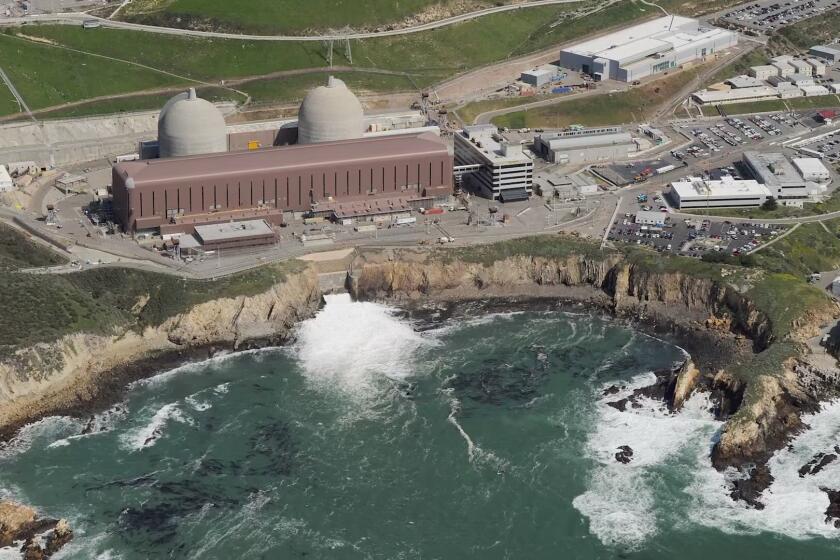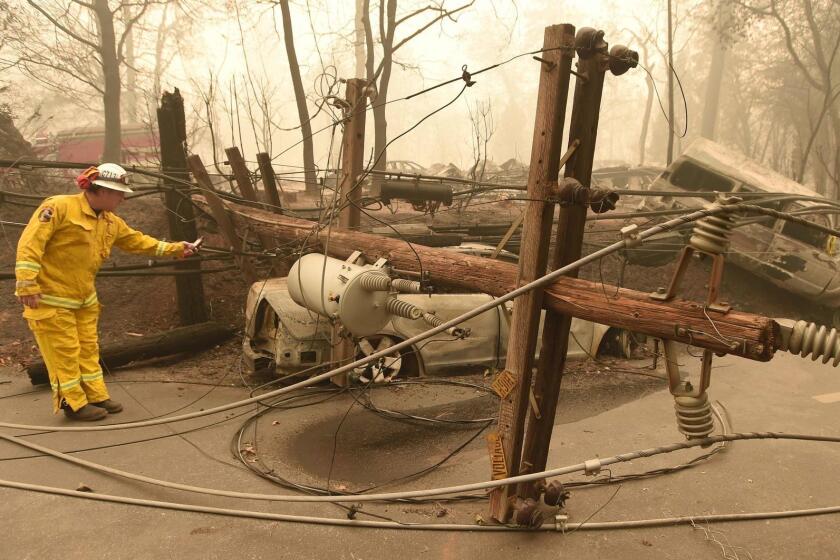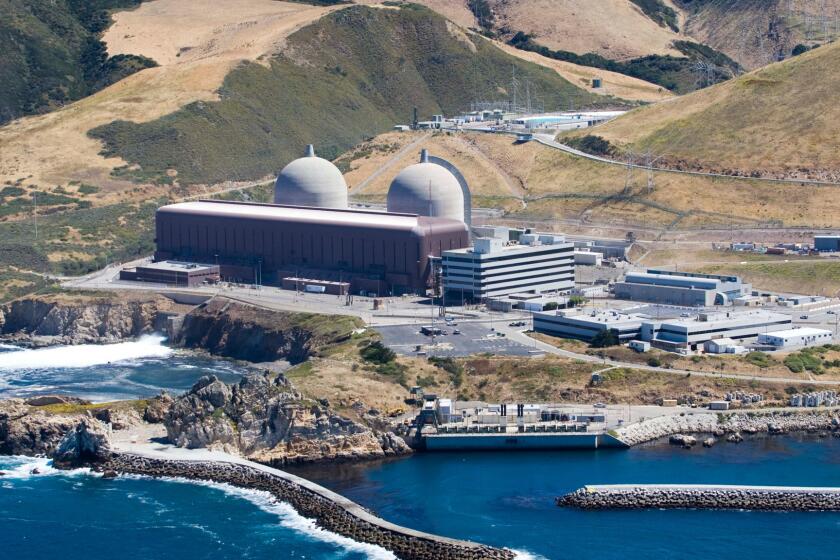Column: Keeping the Diablo Canyon nuclear plant open is a dangerous waste of effort and money

- Share via
When it comes to resurrection stories, the Bible’s Lazarus may have nothing on the Diablo Canyon nuclear power plant.
The plant’s two generating units, which went online in 1985 and 1986, lie on the coast near San Luis Obispo within 20 miles of four active earthquake faults.
The faults were apparently unknown to the plant’s owner, Pacific Gas & Electric, which certified during the construction period that no such faults existed within that distance. Unit 2 was built in accordance with flawed blueprints.
What possible basis could there be for doing this in the final two weeks of the legislative session?...It’s a gigantic take-it-or-leave-it package.
— Ralph Cavanagh, Natural Resources Defense Council
There have been efforts to close the plant for years, gaining intensity as PG&E’s atrocious safety record came to light; twice in the last two years the company has faced criminal charges for its role in igniting wildfires that burned thousands of acres, destroyed hundreds of structures and caused deaths and injuries. (The company pleaded guilty to 84 criminal counts in 2020.)
With all that in mind, plus the crippling expense of required seismic and environmental upgrades to the plant, PG&E agreed in 2016 to shut its two units down in 2024 and 2025, the original expiration dates of their federal licenses.
Get the latest from Michael Hiltzik
Commentary on economics and more from a Pulitzer Prize winner.
You may occasionally receive promotional content from the Los Angeles Times.
The shutdown deal was hailed as a landmark, closing the book on California’s checkered history with nuclear power.
Despite all that, Diablo Canyon has suddenly emerged as a centerpiece of Gov. Gavin Newsom’s plan to maintain the reliability of the state’s electric grid in the face of increasing global warming.
With only days left in the legislative session, Newsom’s office unveiled a proposal to keep Diablo Canyon operating for as long as another decade past the shutdown dates.
Newson’s proposal would provide a $1.4-billion “forgivable” loan to the utility to cover maintenance costs and the expense of resubmitting the plant for federal licensing. The term “forgivable” means that the loan would really function as a grant to the nation’s largest private utility.
As my colleague Sammy Roth observes, the revival of Diablo Canyon would be exempt from state and local environmental reviews and coastal regulations.
Although under traditional utility economics, PG&E’s electric customers have paid for the construction and operating costs of the plant, under the Newsom plan all California utility customers — in other words, almost everybody — would become responsible for the plant’s $460 million in annual operating costs and $300 million in replacement power costs during Diablo Canyon outages.
Plainly, this scheme is lunacy.
Column: Nuclear energy backers say it’s vital for the fight against global warming. Don’t be so sure
Nuclear power proponents say their technology is ‘green.’ But the history of nuclear power is one of broken promises of safety and profitability.
The governor’s underlying concern is that renewable energy sources such as solar and wind don’t generate power when the sun goes down and the wind abates, leaving Californians at the mercy of the elements. Advocates of keeping Diablo Canyon operating often invoke the summer of 2020, when a surge in demand outstripped electric supply, leading to rolling blackouts in parts of the state on two days.
If the plant’s shutdown leaves a supply shortfall after 2025, according to a presentation at a Friday evening workshop sponsored by the California Energy Commission, the state would have little choice other than to institute blackouts again or fire up pollution-producing gas-fueled power plants.
A legislative summary distributed by the governor’s office bristles with alarming prose, mentioning “unprecedented stress on California’s energy system” caused by climate change and “supply chain disruptions” interfering with installation of clean energy infrastructure and raising the specter of a repeat of the high-summer brownouts of 2020.
The problems caused by global warming are not exactly a surprise, supply chain disruptions have already been easing, and the brownouts didn’t recur in 2021 or (so far) this year. Yet the governor is trying to force the Legislature to treat the shutdown of Diablo Canyon as an emergency.
“What possible basis could there be for doing this in the final two weeks of the legislative session?” asks Ralph Cavanagh, energy co-director at the Natural Resources Defense Council. “There will be no opportunity for hearings, no inclusive discussion, it’s a gigantic take-it-or-leave-it package.”
Nor is the governor’s proposal backed up with any technical analysis justifying placing the continued operation of Diablo Canyon ahead of all other options for increasing the state’s energy resources between now and 2035 — such as more rooftop solar, more wind, offshore wind farms, and expanded large capacity battery storage.
“If we do have a reliability problem,” says Mark Specht, Western states energy manager for the Union of Concerned Scientists, “then why aren’t we looking at all the alternatives we might be able to pursue, that may be significantly less expensive than keeping Diablo Canyon online?”
Customers, regulators, suppliers and employees are justifiably nervous about Tuesday’s bankruptcy filing by Pacific Gas & Electric, California’s biggest utility.
Even if it’s assumed that California would have a shortfall in energy resources during the times of peak demand — a summer heat wave driving up air conditioner usage when wildfire smoke is simultaneously reducing the efficiency of solar panels, say — keeping a nuclear plant running is about the least flexible remedy for filling a transient need.
“Diablo Canyon is not a flexible resource that can surge when demand surges,” Cavanagh told me. “It runs 24/7.”
Among the most glaring holes in the governor’s proposal is the failure to even mention what may be the cheapest replacement resources of all: energy efficiency and conservation. Californians are old hands at this process; during the 2000-01 energy crisis, the state reduced energy consumption by 4,800 megawatts — the equivalent of more than two Diablo Canyons.
That was achieved by careful planning, not slapdash last-minute emergency planning, Cavanagh observed at the time. It could be achieved again through more rooftop solar installations and financial incentives for large industrial power users to ratchet back during crisis periods of peak demand.
A few more words about Diablo Canyon’s history might be useful here.
The plant currently provides about 8.6% of California’s total electrical supply and 17% of its non-fossil fueled energy. But it has always been a contentious project — it was the Sierra Club’s support of Diablo Canyon’s construction in the 1960s that prompted environmentalist David Brower to break with the group in 1969 and form Friends of the Earth, which helped to negotiate the shutdown deal.
Doubts about whether PG&E’s corporate culture is capable of managing a major nuclear power plant situated near dangerous earthquake faults have long persisted among nuclear power critics.
What you heard the other day, when Pacific Gas & Electric and a group of environmental organizations and labor unions announced a plan to permanently shutter the Diablo Canyon nuclear plant, was the sound of the door shutting on nuclear power in the United States.
That’s especially so given PG&E’s failure to identify faults near the plant site before it was already under construction. (Indeed, Brower jokingly described nuclear reactors as “complex technological devices for locating earthquake faults.”)
Doubts about the economics of the plant have also persisted. The cost of seismic and environmental refurbishments that would have been mandated by federal regulators if PG&E had gone through with its original plan to seek an extension of its license helped to dissuade the utility from moving forward.
That made PG&E amenable to negotiating the 2016 agreement with environmental groups and labor unions to shutter Diablo Canyon’s two units in 2024 and 2025. That agreement actually represented an extension of the plant’s anticipated life span.
Since then, California energy policy has been supposedly geared toward making up for the loss of Diablo Canyon’s 2,240 megawatts of generating capacity with a combination of efficiency improvements and renewable sources.
This effort is falling short. But that doesn’t warrant reversing course on Diablo Canyon. Among other flaws, the governor’s proposal would turn back the clock by six years with the stroke of a legislative pen.
“Your word is your bond,” says Dan Jacobson, senior advisor to Environment California. “We had a deal, struck by all concerned parties — the utility, the labor unions, the state — that there was going to be an orderly closure of this plant. None of the reasons why people agreed in 2016 to shut the plant down have changed. It’s expensive, dirty and dangerous.”
Environmentalists have a reasonable fear that leaving Diablo Canyon online may reduce the urgency of developing more renewable resources, thus making the climate-driven crisis deeper and longer.
To Newsom’s credit, however, even if Diablo Canyon remained operational, his proposal would require the state’s utilities to continue buying and developing renewable resources as if the plant had been shut down on schedule.
The most curious aspect of the governor’s proposal is its air of urgency, deployed to force the Legislature into declaring Diablo Canyon the indispensable medicine for a crisis that won’t even be upon us until mid-2025 at the earliest.
What’s driving this panic-mongering? It’s hard to discern why Newsom has put so many eggs in the Diablo Canyon basket, unless it’s a desperate bid to avoid high-summer blackouts at all costs while he’s being mentioned as a possible presidential candidate. PG&E hasn’t even lobbied to keep Diablo Canyon operating beyond 2025; its climate strategy report, issued this summer, doesn’t mention that option even once. Instead, it talks about its intention, “once Diablo Canyon ceases operations ... [to] bring more renewable energy online.”
That’s unsurprising, given the likely expense of gearing up for a recommissioning application for Diablo Canyon before the federal Nuclear Regulatory Commission.
The seismic and environmental upgrades that would have been required six years ago for licensing renewal haven’t gotten any cheaper, and PG&E is considerably less financially healthy now than it was then. Reopening the Diablo Canyon can of worms may be the last thing the utility needs right now.
The Legislature’s proper course is obvious. Don’t get drawn into a panicky instant response to a distant crisis. Above all, let Diablo Canyon die on schedule. As Cavanagh recently wrote in a post also referring to the biblical Lazarus, restored to life from his own tomb, “one resurrection is the limit.”
More to Read
Get the latest from Michael Hiltzik
Commentary on economics and more from a Pulitzer Prize winner.
You may occasionally receive promotional content from the Los Angeles Times.














